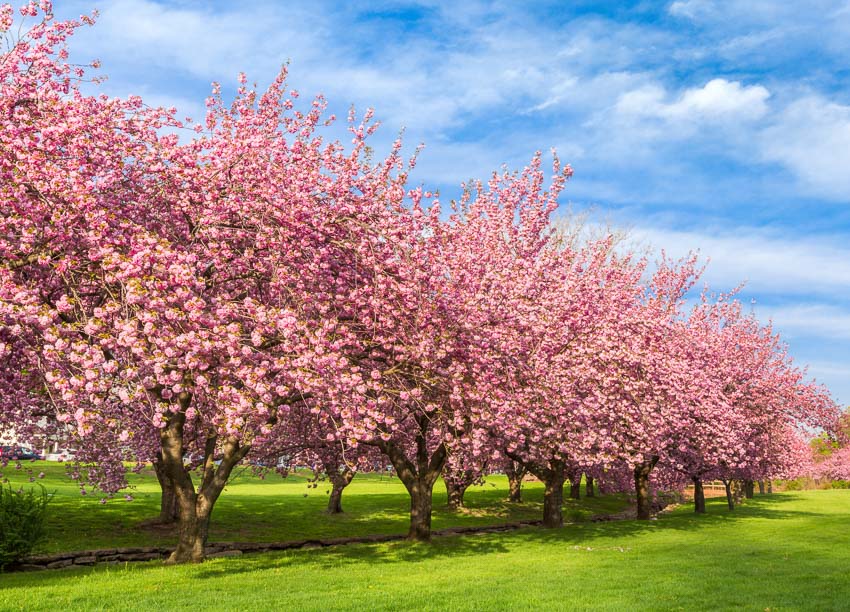Flowering trees are easy to grow, attracting wildlife and adding beauty to your landscape from spring to fall. Find the best flowering trees for your yard with this complete selection, care, and cultivation guide.
Exploring Different Types of Flowering Trees
Once you begin the journey into the world of flowering trees, you’ll become enchanted by the possibilities. Learn more about the best flowering trees for your yard.
Cherry Blossom Trees
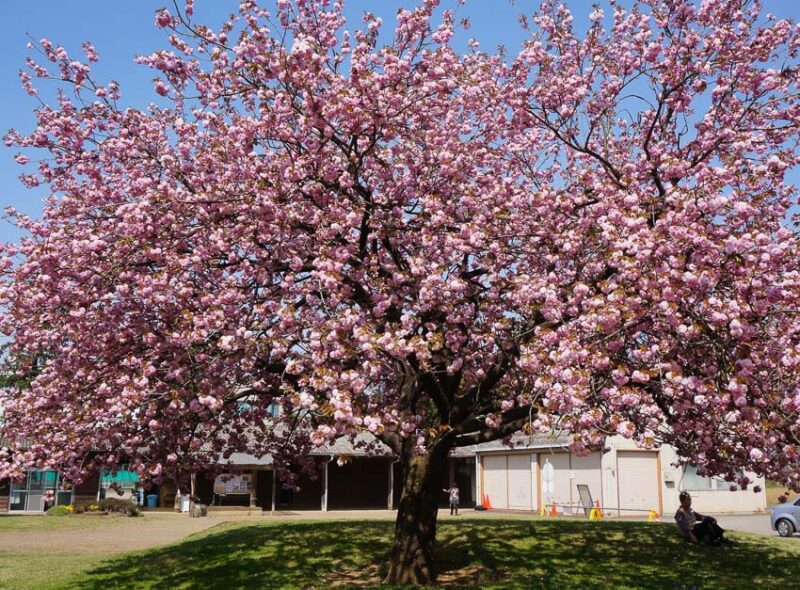
Cherry trees are members of the Rose Family, with over 100 genera and up to 4,000 species. This family of trees includes plums, apples, pears, and almonds, making it one of the world’s most economically significant plant families.
Flowering cherry trees belong to the genus Prunus and are close relatives of plums. There are about 430 species in this genus, native to all parts of the Northern Hemisphere, with the largest concentration coming from Asia.
Many people grow cherry trees for their fruit, but they also select them for landscapes because of their amazing show of flowers. They grow seven species of flowering cherry trees specifically for their showy displays of early spring blossoms, including the following species:
- Taiwan cherry (Prunus campanulata)–a large shrub or small tree native to Asia
- Fuji cherry (Prunus incisa)–named for the incisions on its leaves
- Yamazakura (Prunus jamasakura)–also known as Mountain Cherry, it grows wild in some parts of Asia
- East Asian cherry (Prunus serrulata)–a species that grows naturally in Japan
- North Japanese hill cherry (Prunus sargentii)–a large species of flower cherry that grows to 30 feet
- Winter flowering cherry (Prunus subhirtella)–a naturally occurring hybrid flowering cherry tree that grows to 50 feet
- Oshima cherry (Prunus speciosa)–a tree with white flowers and small black fruit
There are several cultivars of each type of flowering cherry, as they have been cultivated for thousands of years.
Dogwood Trees
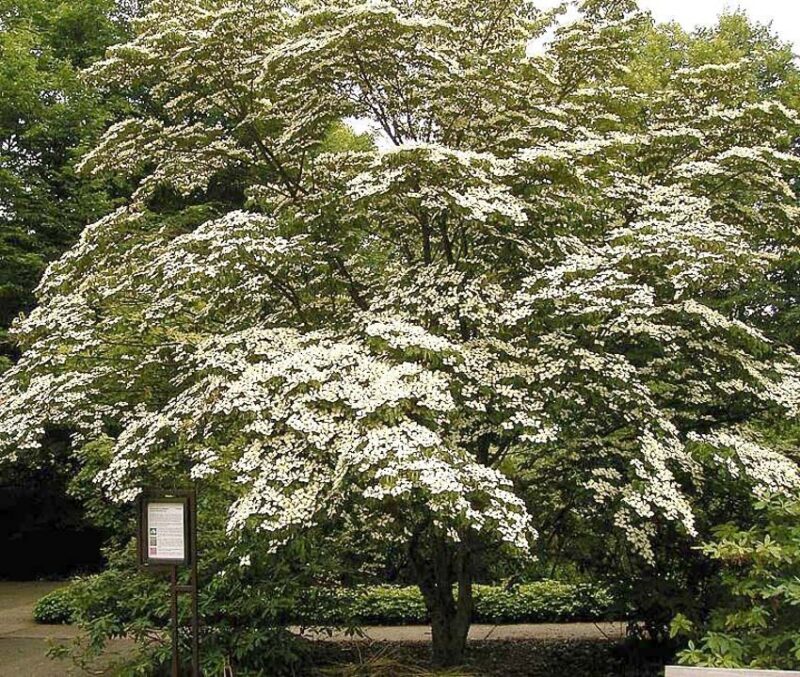
Flowering dogwood trees in the genus Cornus are a sight to behold. The flowers range from white to dark pink and stay on the tree for up to four weeks in the spring.
There are 17 varieties of dogwood native to North America. The most common species cultivated are Pacific dogwood (Cornus nuttallii) and Japanese dogwood (Cornus kousa). Cornelian cherry dogwood (Cornus mas) is this genus’s best small flowering tree.
A fungus called anthracnose threatens some species of dogwood trees, making it important to check them regularly for symptoms.
Many of the fruit of the plants in this genus aren’t poisonous, but they can cause gastrointestinal distress in humans. It’s best to leave the bright red berries produced by dogwood trees for squirrels and birds, who love them.
Magnolia Trees
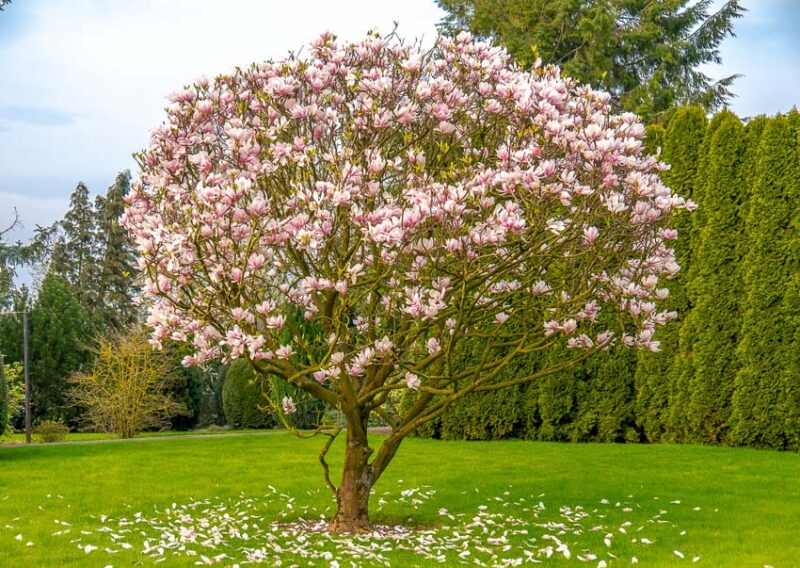
Magnolia is a large genus of trees native to North America, South America, and eastern Asia. There are over 200 species in the genus, which has both evergreen and deciduous varieties.
The flowers of magnolia trees can be as small as a few inches in diameter to over 12 inches, or the size of a dinner plate. The species of magnolia with the largest flowers is Atlas, which has blossoms that are 14 inches across.
Magnolias are famous for their large flowers, which are also incredibly fragrant. Fragrant flowers attract pollinators, and in the wild, wingless beetles pollinate magnolias, which evolved before other types of insects.
The blossoms come in white, yellow, pink, and purple flowers. Some white flowers are stark white, while others are a smooth cream color.
The foliage on evergreen magnolias is magnificent and showy, and in the winter, the luxurious leathery leaves of cultivars like ‘Bracken Brown Beauty’ are a sight to behold. Some greenery you can cut and bring indoors on cold winter days.
Redbud Trees
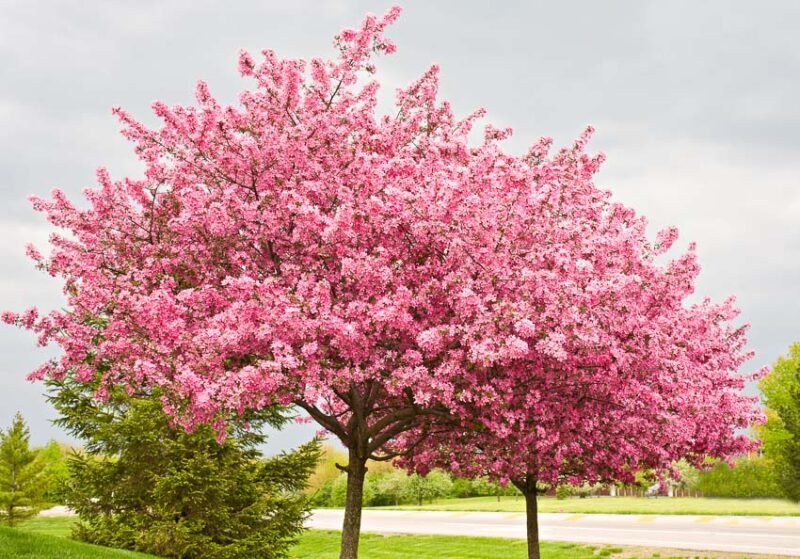
Redbud trees are in the same family as peas and beans, which seems weird, but when you look at their flowers and seed pods, it’s easy to see the resemblance.
There are about ten species of redbud trees, native to many parts of the world, including temperate regions in North America, Europe, and Asia. There are many cultivars to choose from, including weeping and dwarf varieties.
The most common species is Eastern redbud (Cercis canadensis), with a native range from Canada to central Mexico. They thrive in Zones 4 to 9 and grow in many parts of the United States.
Redbud trees are a strikingly beautiful flowering tree, best known for their heart-shaped leaves and reddish-pink flowers, which bloom before foliage appears. They can be grown as a single-stemmed tree or a multi-branched shrub.
Here are some of the best cultivars to choose from:
- Eastern Redbud–a tree with pink flowers that heralds the arrival of spring
- Flame Thrower Redbud–a disease-resistant cultivar with orange, red, and chartreuse leaves
- Black Pearl Redbud–the deep purple flowers and leaves make this a fantastic choice for an accent tree
- Golden Falls Weeping Redbud–a fun weeping cultivar with pink flowers and bright greenish-yellow leaves
- Rising Sun Redbud–a dwarf species with lavender flowers and multicolored leaves
When selecting a redbud tree for your yard, choose one well-suited to your hardiness zone and the amount of space you have.
Crabapple Trees
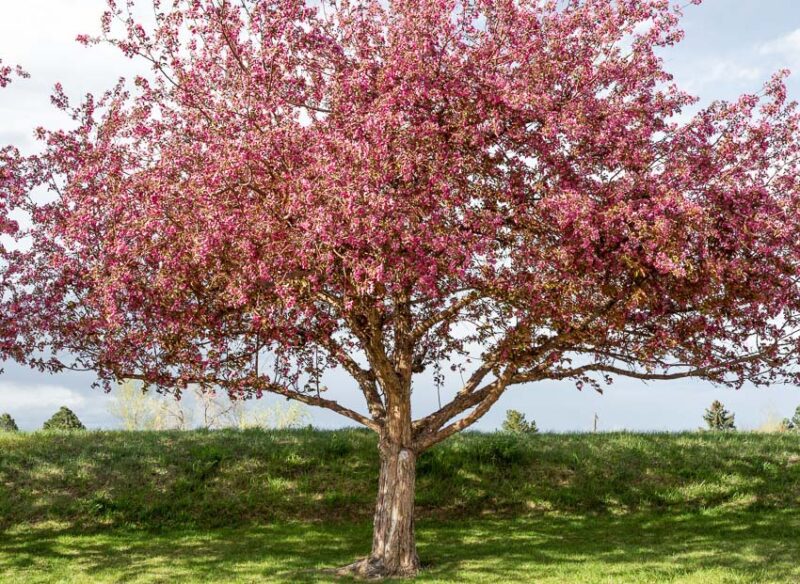
The decision to plant a crabapple tree opens the door to a whole new world. It’s a decision that will last a lifetime because these are long-lived trees. With about 900 species of crabapples available, you have a lot of choices.
Crabapples are fruit-bearing trees in the same genus as apples. They range in size from dwarf cultivars about 10 feet tall to large species reaching 40 feet. Most of them have narrow growth habits, and depending on your space, you can choose from dwarf, medium, and tall crabapple trees.
Some crabapples bear fruit as small as ¾ inch, and others have fruit almost as large as a regular apple. The fruit ranges in color from greenish yellow to cherry red.
One thing all crabapples have in common is their amazing display of flowers. There are flowering crabapple trees with white, pink, and rose-colored flowers.
The long-lasting blooms completely cover the tree and attract thousands of pollinators, making it an excellent choice for creating more biodiversity in your backyard. Choose from crabapple species that bloom relatively early to later in spring.
In the fall, crabapples end the growing season with splendid fall foliage. The fruit of many crabapple species is a favorite with all types of birds, attracting flocks of robins, turkeys, grouse, and cedar waxwings until it’s gone.
Choosing the Best Flowering Tree for Your Landscape
Some planning is required when selecting the best flowering trees for your yard. Use these strategies to find the right tree for your yard for the best results.
Assessing Your Landscape
Many people make the mistake of planting trees too close to buildings, roads, and other trees. Trees are long-lived, and where you put them affects your entire landscape in the future.
Choosing the right planting site is as important as selecting the right tree. When you’re assessing your landscape, consider the following factors:
- Make sure there is enough space for the tree you’re planting.
- Find a tree with sun and shade requirements that match your chosen location.
- Don’t plant flowering trees near parking spaces, patios, or children’s play areas. They are messy, especially when the birds eat the fruit in the fall.
- Know your region, microclimate, and USDA Hardiness Zone , and ensure the tree can thrive where you plant it.
Considering Bloom Time
You can ensure a sequence of bloom times in your yard by planting various flowering trees. Even species in the same genus have different bloom times, which you can use to extend the blossom period in your yard.
The same type of tree will have a different bloom time in your neighborhood than in another growing zone, so when considering bloom time, you must do some research.
You can find online bloom calendars for flowering trees so your yard remains in bloom from early March until June.
Desired Aesthetic and Purpose
It helps to have a plan when choosing flowering trees for your yard. What is your intended purpose in planting them?
There are a lot of ways to use flowering trees in landscaping. They can be a backdrop for perennials and shrubs. You can plant them in rows along your driveway or as the focal point in an accent garden.
Some flowering trees can be successfully grown in containers. They are excellent choices for espalier along a garden fence. You have many choices of how to use flowering trees in your yard.
How to Care for Your Flowering Trees
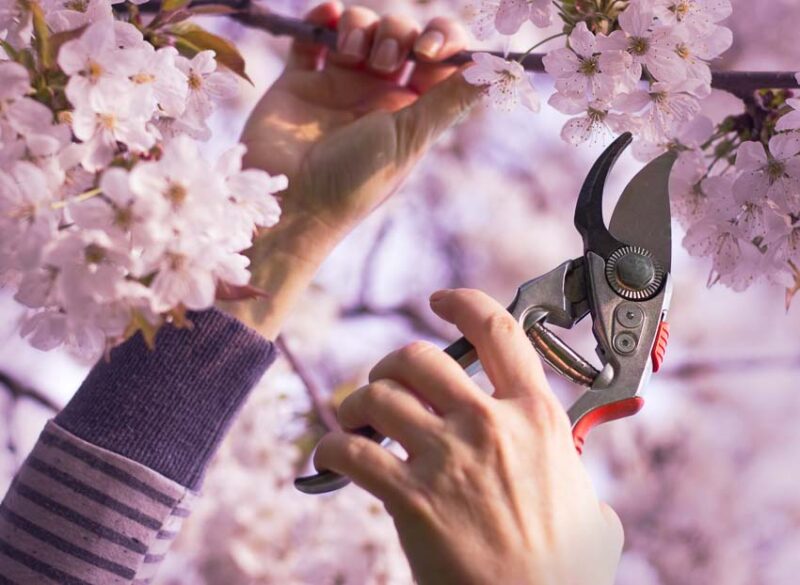
When properly cared for, flowering trees provide you with years of enjoyment. Use these expert tips to care for your flowering trees, from planting to pruning and maintenance.
Planting and Location
If you’ve ever grown fruit trees, you’ll have a good idea about where to plant flowering trees. They need plenty of sun and fertile, well-drained soil.
Before purchasing a flowering tree, ensure the selected cultivar will thrive in your growing zone. Some redbud species, for example, are hardy from Zones 4 to 8, while others are hardy from Zones 5 to 9.
Watering and Fertilizing
Fertilize your flowering trees when you plant them, and again in the spring every year. Use a slow-release organic fertilizer, such as steer or horse manure, and cover it with mulch for best results.
Until young trees are established, they need frequent watering, especially during summer dry spells. Consider using a drip irrigation system to water them deeply twice a week.
Taper off the watering after the temperature drops in the fall so your tree can go dormant. Once the leaves drop, you can resume watering if necessary.
Pruning and Maintenance
For spring bloomers, which set their buds for the following year in the summer and fall, the best time to prune flowering trees is right after they bloom in the spring.
For late-blooming trees, like some magnolias and dogwoods, prune in late winter or early spring. Prune dead or diseased branches as you notice them to keep your trees in good condition.
Other common maintenance issues, like getting rid of deer or eliminating gophers, must also be addressed to keep your flowering trees healthy.
FAQ: Common Questions About Best Flowering Trees
1. Can I grow flowering trees in containers?
Flowering trees can be grown in containers. Choose a large container, and make sure to water and fertilize your tree more often when it’s planted in a container. Eastern Redbud is one of the best flowering trees for containers.
2. How often do flowering trees need to be pruned?
The best time to prune flowering trees is right after the spring bloom time. The flowers and redbud seed pods are only produced on old tree growth, so it’s best to wait until after they flower to prune them.
3. Can I attract pollinators with flowering trees?
Flowering trees are often the first flowers to appear in spring, making them an important pollen source and nectar for pollinators. Pollinator populations are declining globally due to habitat loss, and providing flowering trees is a great way to support pollinators in your region.
4. Do flowering trees require special soil conditions?
Most flowering trees need rich soil with adequate moisture. It’s best to check the specific needs of each type of plant, but in general, your tree will need moist, well-drained soil. Fertilize once a year in the spring with organic fertilizer, and provide plenty of water during summer dry spells.
5. When is the best time to plant flowering trees?
The best time to plant trees is the spring. It’s a perfect time to be outside, and many nurseries have the plants you’re looking for. If you miss spring planting, the second-best time to plant trees and shrubs is in the fall. Try to plant from mid-August to mid-October, when soil temperatures are cool but not frozen.

